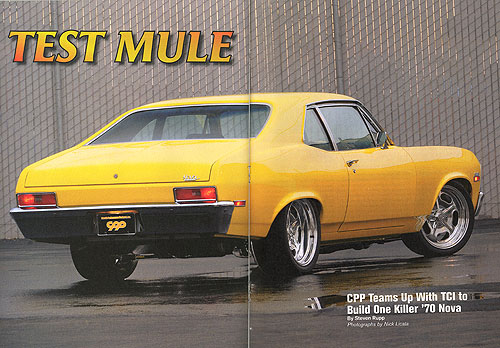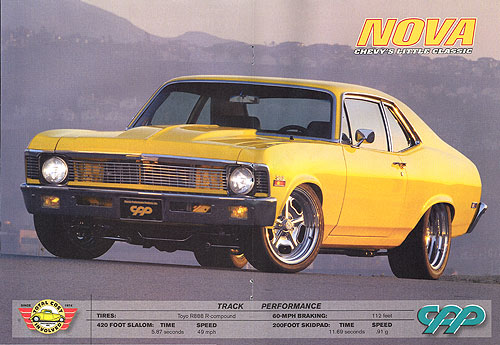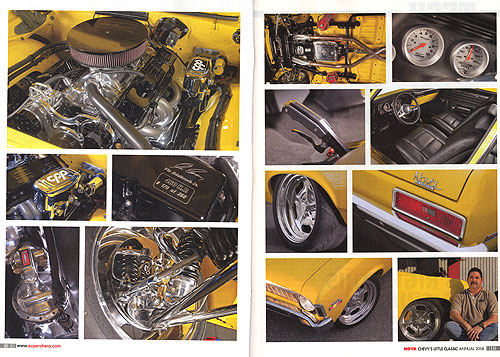
 |
T |
|
|
The Nova looked like you would expect a $2,500 car to look: beat. It ran pretty strong, but it had zero redeeming features aesthetically. The body panels were painted a variety of colors, and the ride was just plain tired. "Solórzano’s first glimpse of the car was when it showed up at the track, and I don't think he was very impressed with its condition. At first, he couldn't stop laughing!" remarked Jim. Once the laughter died down, they decided to baseline the car. The performance was what you would expect from a worn car on hard tires. The 420 slalom was negotiated at 40.9 mph, and the Nova managed 0.74 g on the skidpad. Braking was then tested, and the '70 was able to go from 60 mph to a dead stop in 174 feet. The one request Solórzano had was that Jim at least paint the car all one color. Jim said that if he could just have five weeks, he would bring back a car worthy of Solórzano’s planned suspension transformation. Jim was about to find out that five weeks isn't nearly as long as it sounds.
 |
T |
|
T
|
With the bodywork done and the Nova wearing a fresh coat of PPG Corvette yellow paint, it was sent over to TCI for some much needed suspension updating. The front subframe was ditched, and in its place went TCl's clip. The new IFS subframe features a doublerail, mandrel-bent design and is completely heliarc welded for strength. It also comes with everything from tubular control arms to rack and-pinion steering and dropped spindles. With such a capable front suspension, TCI wanted to give the back of the Nova the same attention, so they bolted in their performance four-link system. The system employs unequal length adjustable links and includes adjustable coilover shocks, just like the front, and a fully tunable track bar. From start to finish the Nova was in TCI's shop for two weeks. It was then ready to head back to CPP for the final assembly. The car was coming out so nice that a decision was made to have the Nova at the '07 SEMA Show in Vegas, but that meant CPP only had three weeks to finish the build.
With the Nova back at CPP, Jim and the team needed to tackle the biggest item first, the drivetrain. With only weeks until SEMA, a custom engine was out of the question. They needed instant gratification, so a call was made to Leadblock, and a couple of days later one of their new limited-edition Signature Series 383 stroker mills was in their shop. Rated at 460 horsepower and an equal amount of twist, the small-block features a host of goodies, including a forged steel crank, hydraulic roller camshaft, aluminum E-Tec 200 heads, and a pump gas-friendly 9.5: 1 compression ratio. Since the crate engine came complete from pan to air cleaner, the team was saved valuable time. To keep the stroker running cool, they opted for a BeCool modular system centered a round an aluminum four-row radiator, and for a drive system they sourced a black-anodized pulley and bracket set from Zoops. Exhaust from the mill exits through a set of S&S headers and into a 2.5-inch stainless Magnaflow system installed by Fantasy Muffler in Buena Park, California. Backing up the new engine is a TCI Street Fighter 700-R4 overdrive transmission with a 10-inch, 2,200-rpm stall converter that shifts the power through an aluminum Inland Empire Driveline driveshaft and into the Currie-built 9-inch Ford rearend.
 |
|
|
T
|
The interior was done in a slightly updated stock style. OE door panels work well with the leather-covered seats done by Padrinos Upholstery. A complete set of Auto Meter gauges tracks the vitals and resides in a Covan's dash panel. A CPP steering wheel provides driver input to the front wheels, while a BTM ratchet shifter keeps the Nova in the right gear. There's also a Classic Auto Air system to keep the occupants suitably chilled on hot summer days. We know what you're asking, "Was it done in time for SEMA?" "We put the interior in just in time to get it to the SEMA Show with only two hours to spare. If I had to change one thing about this build, I would have allowed for more time so we wouldn't have had to pull so many all-nighters at the end;' remarked Jim.
After SEMA, and with only four miles on the odometer, the Nova was brought out to our testing venue at California Speedway in Fontana, California. The Nova equipped with the new suspension and braking systems, looked 100 percent better. But this was a track test and not a car show, so cones were lined up and the Nova was sent hurtling through them. Jim recalled, "The car had less than four miles on it, so we were confident, but nervous; anything could have gone wrong:' The Nova was also wearing appropriate shoes this time in the form of R-compound Toyo R888 DOT competition tires. After a couple of runs to get a feel for the car, a best run of 49 mph was nailed in the slalom, a vast improvement over what the Nova did in stock form. An equally impressive gain was made in skidpad performance when the Nova ran our 200-foot skidpad. With the tires clawing for traction, the best average number ended up being .91 g. Over on our braking track, CPP's yellow Chevy stopped on a dime, with change to spare, and went from 60-0 mph in a mere 112 feet. But the most impressive change in the Nova was how much nicer it is now to drive on the street.
With the SEMA deadline met and a successful track-testing trip, what's in store for the Nova now? Well, lots of road miles since the guys at CPP have grown pretty fond of the little Nova they worked with TCI to build. We can only imagine everyone in the shop jockeying for the keys, and after spending some time in the driver's seat, we can't blame them a bit. ...
To see video of the CPP Nova in action, CLICK HERE.